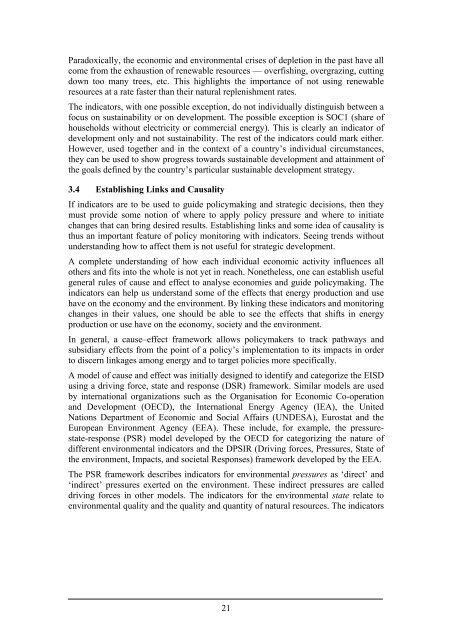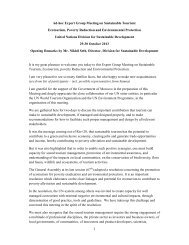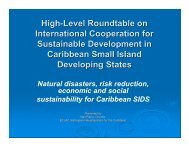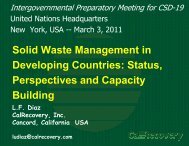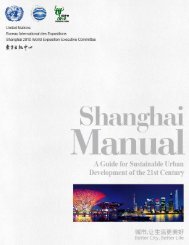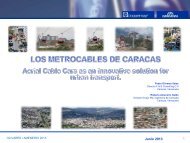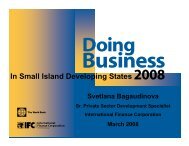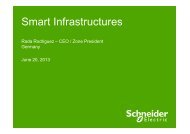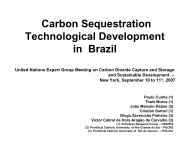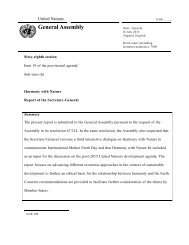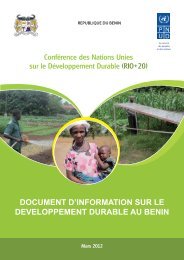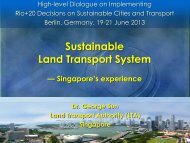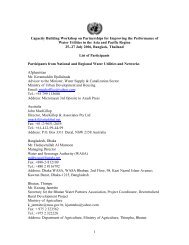3.2.4 Institutional DimensionThe EISD do not yet include institutional indicators. These indicators are the mostdifficult to define <strong>for</strong> two reasons. First, they tend to address issues that are, by nature,difficult to measure in quantitative terms. Many of these issues relate to the future andrequire dynamic analysis based on projections of energy production, use andinvestment. Second, the variables measured by institutional indicators tend to bestructural or policy responses to sustainable development needs.For example, institutional indicators might help to measure not only the existence butalso the effectiveness of a national sustainable energy development strategy or plan,energy statistical capacity and analytical capabilities, or the adequacy andeffectiveness of investments in capacity building, education or research anddevelopment. Institutional indicators could also help to monitor progress towardsappropriate and effective legislative, regulatory and en<strong>for</strong>cement institutions <strong>for</strong>energy systems.Infrastructure is the backbone of any national energy system. Countries need tomonitor the state of their major energy infrastructures to ensure a sustainable energyfuture. Many countries now depend on major energy infrastructures that are obsolete,inefficient, insufficient or environmentally unacceptable.3.3 Accommodating National Sustainability and <strong>Development</strong> PrioritiesSome caveats are in order about the use of the EISD and their interpretation <strong>for</strong>monitoring progress towards sustainable energy development. Since the publication ofthe Brundtland Report, countries have begun to define their own sustainabledevelopment objectives and priorities, reflecting national resources and needs,aspirations, and social and economic conditions. <strong>Sustainable</strong> development strategiesmust there<strong>for</strong>e be structured to accommodate a wide range of definitions of whatdesirable sustainable development can encompass, and monitoring the success of suchstrategies through indicators must also avoid rigid definitions or judgements aboutwhat is universally desirable and necessary.For example, it is possible <strong>for</strong> an economy to be sustainable without developing. Thiswas true of hunter-gatherer groups living twenty thousand years ago. It is alsopossible <strong>for</strong> a country to develop without its development being sustainable. Thiswould be true of a country completely dependent on a lucrative and highly effectivefishing industry that generates high income levels, thus enabling investment inschools, hospitals, art galleries and welfare services, but that also exhausts the fishstocks. This country would have achieved a degree of development, but thatdevelopment would not be sustainable since it is destroying the country’s source ofincome.However, it is also true that the depletion of resources does not necessarily implyunsustainable development. By definition, if an energy source is not renewable, anyuse of it is irreversible. But this does not mean it should never be used. Consider acountry with a natural gas field that uses all of the gas in a way calculated to bring infunds to build up its economy and technology, and then moves on to another <strong>for</strong>m ofenergy — <strong>for</strong> example, renewables or imported fuels. This may represent sustainabledevelopment. The depletion of the gas field by one generation does not necessarilyjeopardize the energy supply <strong>for</strong> future generations.20
Paradoxically, the economic and environmental crises of depletion in the past have allcome from the exhaustion of renewable resources — overfishing, overgrazing, cuttingdown too many trees, etc. This highlights the importance of not using renewableresources at a rate faster than their natural replenishment rates.The indicators, with one possible exception, do not individually distinguish between afocus on sustainability or on development. The possible exception is SOC1 (share ofhouseholds without electricity or commercial energy). This is clearly an indicator ofdevelopment only and not sustainability. The rest of the indicators could mark either.However, used together and in the context of a country’s individual circumstances,they can be used to show progress towards sustainable development and attainment ofthe goals defined by the country’s particular sustainable development strategy.3.4 Establishing Links and CausalityIf indicators are to be used to guide policymaking and strategic decisions, then theymust provide some notion of where to apply policy pressure and where to initiatechanges that can bring desired results. Establishing links and some idea of causality isthus an important feature of policy monitoring with indicators. Seeing trends withoutunderstanding how to affect them is not useful <strong>for</strong> strategic development.A complete understanding of how each individual economic activity influences allothers and fits into the whole is not yet in reach. Nonetheless, one can establish usefulgeneral rules of cause and effect to analyse economies and guide policymaking. Theindicators can help us understand some of the effects that energy production and usehave on the economy and the environment. By linking these indicators and monitoringchanges in their values, one should be able to see the effects that shifts in energyproduction or use have on the economy, society and the environment.In general, a cause–effect framework allows policymakers to track pathways andsubsidiary effects from the point of a policy’s implementation to its impacts in orderto discern linkages among energy and to target policies more specifically.A model of cause and effect was initially designed to identify and categorize the EISDusing a driving <strong>for</strong>ce, state and response (DSR) framework. Similar models are usedby international organizations such as the Organisation <strong>for</strong> Economic Co-operationand <strong>Development</strong> (OECD), the International <strong>Energy</strong> Agency (IEA), the UnitedNations Department of Economic and Social Affairs (UNDESA), Eurostat and theEuropean Environment Agency (EEA). These include, <strong>for</strong> example, the pressurestate-response(PSR) model developed by the OECD <strong>for</strong> categorizing the nature ofdifferent environmental indicators and the DPSIR (Driving <strong>for</strong>ces, Pressures, State ofthe environment, Impacts, and societal Responses) framework developed by the EEA.The PSR framework describes indicators <strong>for</strong> environmental pressures as ‘direct’ and‘indirect’ pressures exerted on the environment. These indirect pressures are calleddriving <strong>for</strong>ces in other models. The indicators <strong>for</strong> the environmental state relate toenvironmental quality and the quality and quantity of natural resources. The indicators21
- Page 2 and 3: Photos on the cover:D. Kinley, IAEA
- Page 4 and 5: COPYRIGHT NOTICEAll IAEA scientific
- Page 6 and 7: IAEA Library Cataloguing in Publica
- Page 8 and 9: agency report. Their work also bene
- Page 10 and 11: Environmental Dimension ...........
- Page 12 and 13: progress towards sustainability. Fi
- Page 15 and 16: 2. BACKGROUNDSince the publication
- Page 17 and 18: presented in this report. A short d
- Page 19 and 20: In the 2004 edition of the World En
- Page 21 and 22: 3. ENERGY INDICATORS FOR SUSTAINABL
- Page 23 and 24: EconomicTheme Sub-theme Energy Indi
- Page 25 and 26: EnvironmentalTheme Sub-theme Energy
- Page 27 and 28: income. Inadequate equipment and ve
- Page 29: the cost of delivery are necessary
- Page 33: • Shares of sectors in GDP value
- Page 36 and 37: might be collected by another, or t
- Page 38 and 39: 4.3. Priorities and Approaches for
- Page 40 and 41: (b) Relevance to Sustainable Develo
- Page 42 and 43: • IEA, various editions. Energy S
- Page 44 and 45: (b) National and International Data
- Page 46 and 47: energy availability and affordabili
- Page 48 and 49: SOC4: Accident fatalities per energ
- Page 50 and 51: Proceedings of a Technical Committe
- Page 52 and 53: REFERENCES• IEA, various editions
- Page 54 and 55: geography and the structure of the
- Page 56 and 57: (b) Relevance to Sustainable Develo
- Page 58 and 59: • UNSD, various editions. Energy
- Page 60 and 61: • USGS, various editions. World P
- Page 62 and 63: ECO6: Industrial energy intensities
- Page 64 and 65: Units: toe for final energy and kWh
- Page 66 and 67: • Unander, F., Karbuz, S., Schipp
- Page 68 and 69: other inputs, etc). These factors a
- Page 70 and 71: (d) International Targets/Recommend
- Page 72 and 73: ASSESSMENT OF DATA(a) Data Needed t
- Page 74 and 75: oilers and new electric appliances
- Page 76 and 77: Disaggregated Intensities: Using th
- Page 78 and 79: educe the environmental impacts of
- Page 80 and 81:
(d) Alternative Definitions/Indicat
- Page 82 and 83:
(c) International Conventions and A
- Page 84 and 85:
ECO12: Non-carbon energy share in e
- Page 86 and 87:
• IEA, 1990-2001. Energy Statisti
- Page 88 and 89:
ASSESSMENT OF DATA(a) Data Needed t
- Page 90 and 91:
connection to the electricity or ga
- Page 92 and 93:
Further problems include differing
- Page 94 and 95:
Re-exports of oil imported for proc
- Page 96:
(c) International Conventions and A
- Page 99 and 100:
does not show how much the climate
- Page 101 and 102:
• World Bank, various editions. W
- Page 103 and 104:
a time frame as possible so that lo
- Page 105 and 106:
ENV3: Air pollutant emissions from
- Page 107 and 108:
METHODOLOGICAL DESCRIPTION(a) Under
- Page 109 and 110:
In the first instance, countries sh
- Page 111 and 112:
ENV4-1: Contaminant discharges in l
- Page 113 and 114:
downstream. Contamination of fresh
- Page 115 and 116:
ENV4-2: Oil discharges into coastal
- Page 117 and 118:
(b) Measuring Methods: Estimates of
- Page 119 and 120:
Acidification is a priority atmosph
- Page 121 and 122:
national authorities under the CLRT
- Page 123 and 124:
United Nations Convention to Combat
- Page 125 and 126:
• Harcharik, D.A., 1995. Forest R
- Page 127 and 128:
indicator, radioactive waste and (s
- Page 129 and 130:
(b) Relevance to Sustainable Develo
- Page 131 and 132:
more easily available, as in many c
- Page 133 and 134:
Agency (IAEA). In 1995, the IAEA pu
- Page 135 and 136:
• Low- and intermediate-level rad
- Page 137 and 138:
ENV10: Ratio of solid radioactive w
- Page 139 and 140:
under development in some countries
- Page 141:
• IAEA, 1997. Joint Convention on
- Page 144 and 145:
EEA, 2002. Review of Selected Waste
- Page 146 and 147:
FAO, 1988. Energy Conservation in A
- Page 148 and 149:
IEA, 2000. The IEA Energy Indicator
- Page 150 and 151:
OECD, 2001. Key Environmental Indic
- Page 152 and 153:
UNEP/WHO, 1992. Urban Air Pollution
- Page 155 and 156:
RELATED INTERNET SITES• CONCAWE (
- Page 157:
• WEC (World Energy Council):http
- Page 160 and 161:
Particulates: Terms commonly associ
- Page 162 and 163:
TOCTPESTSPVOCtotal organic carbonto
- Page 165 and 166:
ANNEX 3: A DECOMPOSITION METHOD FOR
- Page 167 and 168:
Total Final ConsumptionHouseholds T
- Page 169 and 170:
Thus through calculating the relati
- Page 171:
Annex 4: Units and Conversion Facto


